+Search query
-Structure paper
| Title | An inhibitory mechanism of AasS, an exogenous fatty acid scavenger: Implications for re-sensitization of FAS II antimicrobials. |
|---|---|
| Journal, issue, pages | PLoS Pathog, Vol. 20, Issue 7, Page e1012376, Year 2024 |
| Publish date | Jul 15, 2024 |
 Authors Authors | Haomin Huang / Shenghai Chang / Tao Cui / Man Huang / Jiuxin Qu / Huimin Zhang / Ting Lu / Xing Zhang / Chun Zhou / Youjun Feng /   |
| PubMed Abstract | Antimicrobial resistance is an ongoing "one health" challenge of global concern. The acyl-ACP synthetase (termed AasS) of the zoonotic pathogen Vibrio harveyi recycles exogenous fatty acid (eFA), ...Antimicrobial resistance is an ongoing "one health" challenge of global concern. The acyl-ACP synthetase (termed AasS) of the zoonotic pathogen Vibrio harveyi recycles exogenous fatty acid (eFA), bypassing the requirement of type II fatty acid synthesis (FAS II), a druggable pathway. A growing body of bacterial AasS-type isoenzymes compromises the clinical efficacy of FAS II-directed antimicrobials, like cerulenin. Very recently, an acyl adenylate mimic, C10-AMS, was proposed as a lead compound against AasS activity. However, the underlying mechanism remains poorly understood. Here we present two high-resolution cryo-EM structures of AasS liganded with C10-AMS inhibitor (2.33 Å) and C10-AMP intermediate (2.19 Å) in addition to its apo form (2.53 Å). Apart from our measurements for C10-AMS' Ki value of around 0.6 μM, structural and functional analyses explained how this inhibitor interacts with AasS enzyme. Unlike an open state of AasS, ready for C10-AMP formation, a closed conformation is trapped by the C10-AMS inhibitor. Tight binding of C10-AMS blocks fatty acyl substrate entry, and therefore inhibits AasS action. Additionally, this intermediate analog C10-AMS appears to be a mixed-type AasS inhibitor. In summary, our results provide the proof of principle that inhibiting salvage of eFA by AasS reverses the FAS II bypass. This facilitates the development of next-generation anti-bacterial therapeutics, esp. the dual therapy consisting of C10-AMS scaffold derivatives combined with certain FAS II inhibitors. |
 External links External links |  PLoS Pathog / PLoS Pathog /  PubMed:39008531 / PubMed:39008531 /  PubMed Central PubMed Central |
| Methods | EM (single particle) |
| Resolution | 2.19 - 2.53 Å |
| Structure data | EMDB-35008, PDB-8hsy: EMDB-36725, PDB-8jyl: EMDB-36731, PDB-8jyu: |
| Chemicals | 
ChemComp-VUL:  ChemComp-MG: 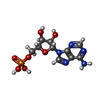 ChemComp-AMP: 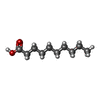 ChemComp-DKA: |
| Source |
|
 Keywords Keywords | CYTOSOLIC PROTEIN / Acyl-ACP synthetase / Tool enzyme / LIGASE |
 Movie
Movie Controller
Controller Structure viewers
Structure viewers About Yorodumi Papers
About Yorodumi Papers




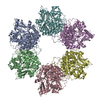

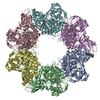

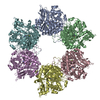
 vibrio harveyi (bacteria)
vibrio harveyi (bacteria)